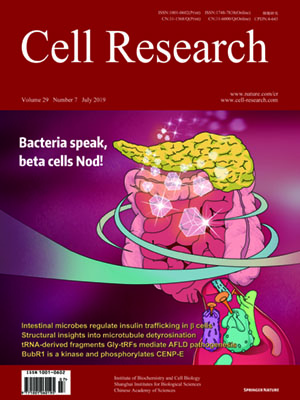
Volume 29, No 7, Jul 2019
ISSN: 1001-0602
EISSN: 1748-7838 2018
impact factor 17.848*
(Clarivate Analytics, 2019)
Volume 29 Issue 7, July 2019: 596-598
LETTERS TO THE EDITOR
Mitochondrial metabolism and glutamine are essential for mesoderm differentiation of human pluripotent stem cells
Vivian Lu 1, Perrine Dahan2, Fasih M. Ahsan2, Alexander N. Patananan2, Irena J. Roy2, Alejandro Torres Jr.3, Robert M. T. Nguyen2, Dian Huang4, Daniel Braas1 and Michael A. Teitell 2,4,5
1 Department of Molecular and Medical Pharmacology, David Geffen School of Medicine, University of California, Los Angeles, Los Angeles, CA 90095, USA; 2Department of Pathology and Laboratory Medicine, David Geffen School of Medicine, University of California, Los Angeles, Los Angeles, CA 90095, USA; 3Department of Chemistry and Biochemistry, University of California, Los Angeles, CA 90095, USA; 4Department of Bioengineering, University of California, Los Angeles, CA 90095, USA and 5Jonsson Comprehensive Cancer Center, Molecular Biology Interdepartmental Program, California NanoSystems Institute, Department of Pediatrics, and Broad Center for Regenerative Medicine and Stem Cell Research, University of California, Los Angeles, CA 90095, USA
These authors contributed equally: Vivian Lu, Perrine Dahan
Correspondence: Michael A. Teitell (mteitell@mednet.ucla.edu)
Dear Editor,
Human pluripotent stem cells (hPSCs) generate energy mainly by aerobic glycolysis, with glutamine oxidation in the tricarboxylic acid (TCA) cycle providing additional ATP required for survival.1,2,3 During the exit from pluripotency and initial differentiation into multiple germ lineage precursors, energy production shifts from mainly aerobic glycolysis to mitochondrial oxidative phosphorylation (OXPHOS).1 Until recently, consensus in the field was that as PSCs exit pluripotency, a metabolic switch from aerobic glycolysis to OXPHOS is required. However, a more detailed examination of nascent ectoderm (EC) metabolism showed unexpected maintenance of a high, MYC-dependent glycolytic flux, resembling sustained hPSC metabolism, in contrast to mesoderm (ME) and endoderm (EN),4 generating questions for the role(s) of mitochondrial metabolism in early hPSC tri-lineage differentiation. To examine this issue, we differentiated hPSCs into early EN, ME, and EC lineages using a non-limiting, nutrient-balanced culture media that differed only by established lineage-driving cytokines,5,6 so that intrinsic metabolic preferences were not derived from a variance in nutrient composition (Supplementary information, Data S1). Principal component analysis (PCA) of these early lineages using RNA-Seq was equivalent to a previous study using nutrient-balanced and chemically defined growth media.4 Furthermore, transcriptomic and protein biomarker expression matched established profiles for hPSCs and hPSC-derived EN, ME, and EC (Supplementary information, Fig. S1a–c, Table S1),7 confirming the validity of our model system.
https://doi.org/10.1038/s41422-019-0191-2
FULL TEXT | PDF
Browse 1173


